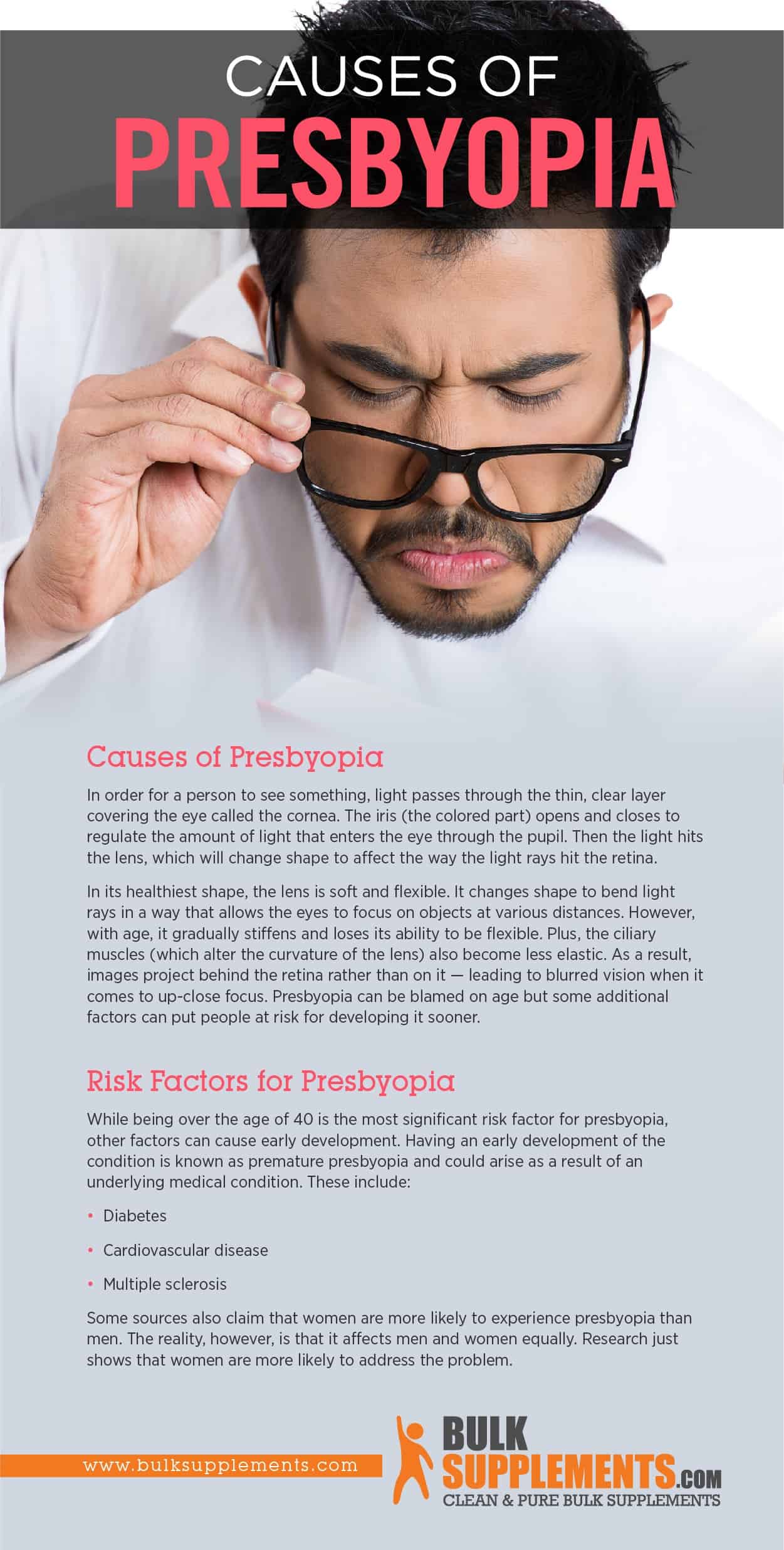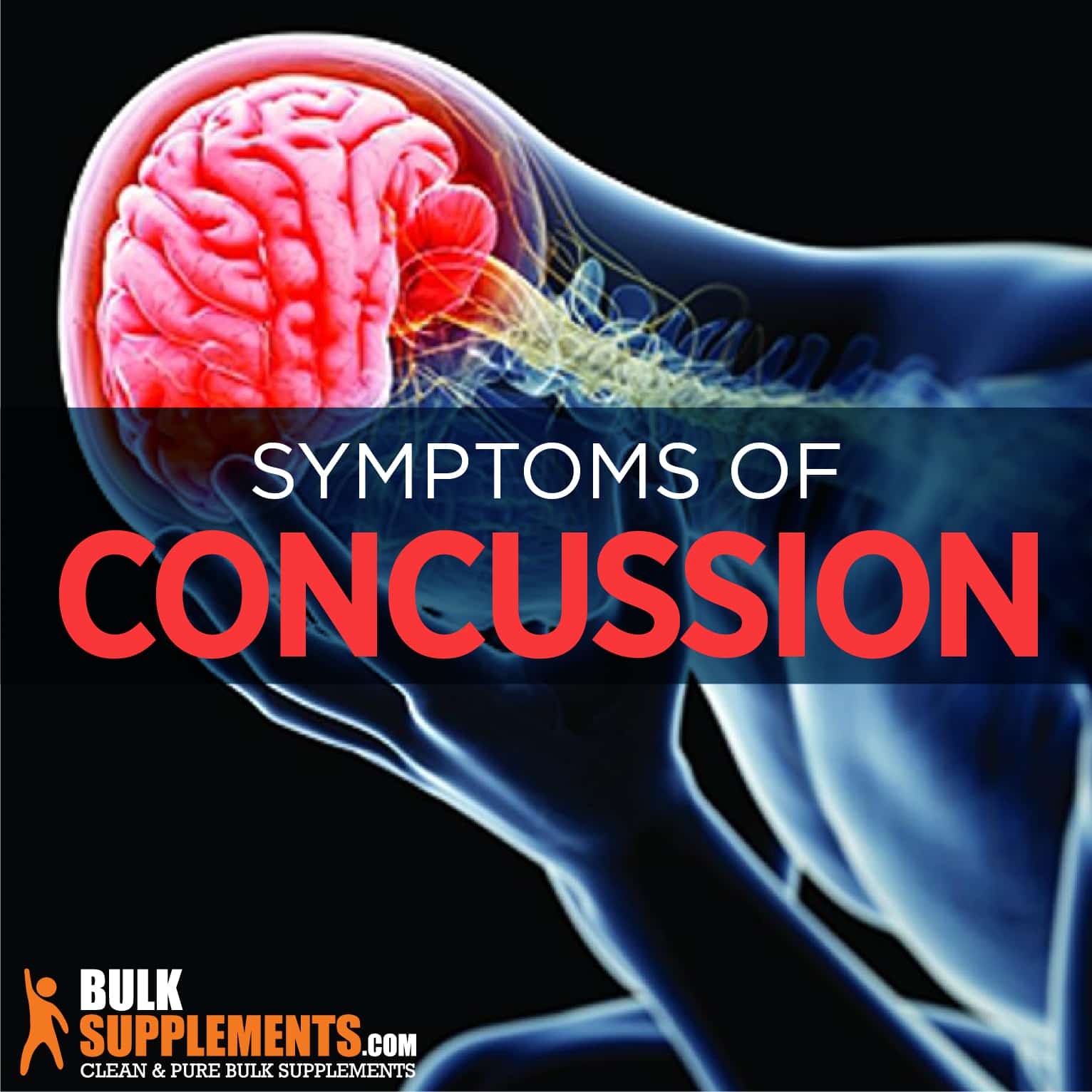Presbyopia: Symptoms, Causes & Treatment

Presbyopia
What is Presbyopia?
Presbyopia is an age-related vision condition whereby the lens of the eyes becomes increasingly inflexible, leading to the inability to focus quickly on nearby objects. It is a natural — often annoying — part of the aging process which nobody can escape, even if you have no previous vision problem. It’s not a condition that comes on suddenly, but rather involves a gradual sight reduction that will continue over a period of years.
As of 2015, about 1.8 billion people worldwide were estimated to have presbyopia. Besides just affecting vision, presbyopia can be a significant emotional event in people’s lives because it’s an indication of aging that can’t be ignored. While other vision problems like astigmatism, farsightedness or nearsightedness can be caused by genetics or an underlying disease, presbyopia is always age-related. In fact, the ancient Greeks refer to presbyopia as “old eye”.
People often confuse presbyopia with farsightedness. However, they are different. For example, presbyopia occurs when the shape of the crystalline lens of the eyes changes and loses flexibility. Farsightedness, on the other hand, occurs when the shape of the eyes is skewed, thus causing light rays to bend the wrong way once in the eyes.
Symptoms of Presbyopia
Some of the signs and symptoms of presbyopia are:
- Eye strain
- Headache after doing up-close work
- Blurred vision even when looking at objects that are close to you
- Difficulty reading small prints
- Visual fatigue during close work
- Squinting
- Requiring brighter lights for reading and other close-up works
- Sensitivity to light
Causes of Presbyopia
In order for a person to see something, light passes through the thin, clear layer covering the eye called the cornea. The iris (the colored part) opens and closes to regulate the amount of light that enters the eye through the pupil. Then the light hits the lens, which will change shape to affect the way the light rays hit the retina.
In its healthiest shape, the lens is soft and flexible. It changes shape to bend light rays in a way that allows the eyes to focus on objects at various distances. However, with age, it gradually stiffens and loses its ability to be flexible. Plus, the ciliary muscles (which alter the curvature of the lens) also become less elastic. As a result, images project behind the retina rather than on it — leading to blurred vision when it comes to up-close focus. Presbyopia can be blamed on age but some additional factors can put people at risk for developing it sooner.
Risk Factors for Presbyopia
While being over the age of 40 is the most significant risk factor for presbyopia, other factors can cause early development. Having an early development of the condition is known as premature presbyopia and could arise as a result of an underlying medical condition. These include:
Some sources also claim that women are more likely to experience presbyopia than men. The reality, however, is that it affects men and women equally. Research just shows that women are more likely to address the problem.

Treatments for Presbyopia
The easiest and most common way to manage presbyopia is by wearing eye glasses with corrective lenses. For some people, contact lenses surgery are more desirable options.
Eye Glasses
The most popular treatment option for presbyopia for those over 40 is the use of eyeglasses. Here are some specifics:
Bifocals
They have two types of focus separated by a visible horizontal line. The upper part is set for distance (nearsightedness) and the lower for reading or up-close work.
Trifocals
These glasses come with two visible horizontal lines on the lenses to indicate three different point of focus. The portions are set for close-up work, midrange vision – i.e., for computer screens, and distance vision.
Progressive Multifocal
This is also referred to as a no-line bifocal. They do not come with a visible line and have the added advantage of providing a seamless transition for middle, distance, and close-up corrections.
Non-Prescription Lens
If you didn’t require eyeglasses before having presbyopia or you are still in the early stage of the condition, then you might be able to use off-the-shelf non-prescription reading glasses. These standard off-the-rack reading glasses are available in office supply stores, supermarkets and drug stores, and may do the trick for reading or close work. However, chances remain that as the presbyopia worsens, you may eventually have to get prescription corrective lenses.
When choosing your non-prescription glasses, try different degrees of magnification, and go for the lowest that allow you read small prints comfortably. Most of these glasses range in power from +1.00 diopter (D) TO +3.00 D. So, if you know the amount of correction you need, you can easily choose the suitable pair for you. If you don’t know how much correction you need, try different powers.
Prescription Contact Lens
If you already use glasses to correct eye issues like astigmatism or nearsightedness, then you will probably need a new prescription to also correct presbyopia. Here are the types to consider:
Bifocal Contact Lens
These provide the same option a the bifocal glasses i.e., close-up and distance correction on each contact
Monovision Contact Lenses
With this type, you will wear a contact lens for close-up vision in one eye, and that for distant vision in the other eye (usually the dominant one)
Modified Monovision Contact Lens
This requires you to wear a bifocal or multifocal contact lens in one eye and a contact lens for distance in the other (usually your dominant eye). Both eyes can be used for distance vision; however, just one is used for reading, and the brain then adjusts to process the image accordingly.
Surgery
There are different surgical options available for treating presbyopia. Here are some:
Conductive Keratoplasty (CK)
This uses radiofrequency waves to change the shape of the cornea to improve its focusing ability by applying heat to tiny spots around the cornea. While the keratoplasty surgery is effective, the correction may diminish over time for some patients.
SEE ALSO

Concussion: Symptoms, Causes & Treatment
Refractive Surgery
This works just like you are wearing monovision contact lenses. The surgery involves creating a steeper cornea so that the eye can focus better on objects that are close up. This procedure is non-reversible, and even after surgery, you may still need prescription eyeglasses for near reading and close-up work.
Lens Implants
This involves the removal of the natural lens and replacing it with a synthetic one referred to as intraocular lens implant. Some of these lenses cover both near and distance vision or either of the two. Possible side effects of lens implants are blurring and glare. Still, it remains a promising treatment option as the complications are rare and the surgery is short. However, it is an irreversible procedure and may even still require reading glasses after surgery.
Corneal Inlay
This is similar in concept to a lens implant, as it involves inserting small plastic ring into the central of the cornea of one eye. It acts like a pinhole camera to increase depth of focus.
Supplements for Vision
Specific nutrients that are available in food as well as supplements play a big role in maintaining good eyesight in general. The U.S. National Eye Institute carried out a large, multi-phase study called the Age-Related Eye Disease Study (AREDS). The most recent phase of the study ultimately identified a combination of six vitamins, minerals and nutrients that can slow age-related vision loss. These nutrients function as antioxidants in the body and reduce oxidative stress on the eyes which is believed to contribute to vision loss. They are:
Vitamin C
Also known as ascorbic acid, vitamin C acts as an important antioxidant in the body. Besides boosting the immune system, promoting healthy skin, and keeping the heart healthy (x), it also helps slow the progression of age-related vision loss. The specific amount found to be effective in the AREDS formula is 500 mg/day. However, it’s generally safe in higher doses and personal preferences on vitamin C doses vary widely.
Vitamin E
Vitamin E refers not just to one compound, but a group of fat-soluble vitamins. The AREDS study recommends 400 IU of vitamin E to keep eyes healthy. As a dietary supplement, take 1 vitamin E 400 IU softgel daily with a meal, or as otherwise directed by a physician.
Zinc
Zinc is highly concentrated in the retina. The AREDS study recommends 80 mg/day of this important mineral for optimal long-term vision. However, more recent studies suggest that lower levels, more like 25 mg/day of zinc, is equally effective for this purpose. These recent findings may be important because currently, the recommended daily allowance (RDA) of elemental zinc for adult women and men is 8 mg and 11 mg per day, respectively. The Tolerable Upper Intake Level (UL), or the amount that most healthy adults can tolerate without negative side effects, set at 40 mg per day for men and women. As a dietary supplement, zinc is available in several forms such as zinc citrate, zinc gluconate and zinc glycinate. Since each has its own dosing instructions, simply follow the directions on the label or as recommended by a doctor.
Copper
Most people don’t have a copper deficiency, which is good because this mineral is very important for the immune system, healthy red blood cells, and of course, vision. According to the AREDS study, 2 mg/day is enough to fight oxidative damage in the eyes. When using as a supplement, caution is advised. Copper is extremely toxic when taken in excess. An analytical milligram scale is required to measure copper gluconate powder. Do not exceed 4 milligrams of elemental copper per day. Not intended for individual use.
Lutein & Zeaxanthin
Though slightly different, these two similar antioxidant compounds often go hand in hand. That’s because they’re both found in high concentrations in the retina and protect the eyes from damaging UV light. Leafy green foods like kale, spinach, mustard greens and lettuce contain lots of lutein and zeaxanthin, as does asparagus, pumpkin, summer squash, broccoli and carrots. Ten mg of lutein and 2 mg of zeaxanthin is recommended for optimal optical health. With a plant based diet, this is easily doable. Alternatively, as a dietary supplement, take 400 mg of lutein 5% powder daily and 100 mg of zeaxanthin 5% powder one to two times daily, or as directed by a physician.
The Bottom Line
Presbyopia is an age-related process that causes thickening and loss of flexibility of the eyes’ lenses. The first signs of presbyopia are noticed by most people after age 40 and continue to worsen till around age 65. You may become aware of the condition when you start to squint and hold reading materials at arm’s length to help your eyes focus. People generally resort to corrective lenses to simply and non-invasively improve vision. However, some invasive surgeries are available. In addition, research shows that good nutrition and supplements can help preserve overall vision.



